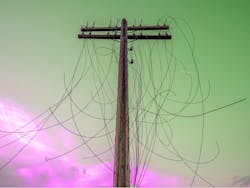Non-wires alternatives use distributed energy resources and microgrids to defer or replace the installation of more traditional “wires and poles” infrastructure. When utilities choose non-wires alternatives, they often save ratepayers money by avoiding investments in costly infrastructure. By utilizing distributed energy resources (DER) at the local level, they provide flexibility and resilience.
More and more, non-wires alternatives are being integrated into the transmission and distribution grid to meet environmental policy concerns and save utilities and ratepayers money. That’s partially because DER technologies have improved, prompting utilities to explore these solutions.
From an environmental perspective, non-wires alternatives may cut carbon emissions through the use of renewable energy that avoids fossil fuel-fired plants. They can also reduce line losses, boost efficiency and shift loads. What’s more, taking advantage of DERs leads to indirect carbon savings by providing flexibility, which can reduce curtailment.
Global spending in non-wires alternatives is expected to increase from $63 million in 2017 to $580 million in 2026, according to a report from Navigant Research.
Non-wires alternatives are in various stages of planning within more than 100 projects; only a small percentage of those have been completed, according to the report, “Non-Wires Alternatives: Case Studies from Leading US Projects,” by the Smart Electric Power Alliance and others.
Non-wires alternatives are not new
The Bonneville Power Administration (BPA) first looked at non-wires alternatives in the Northwest as early as 1987 and has since considered more than 150 potential projects. Pacific Gas & Electric (PG&E) developed its first non-wires alternative in 1991 as a targeted demand-side management measure.
Following up on these early projects, utilities and agencies are expressing new interest because of the increased use of DERs and the ability to take advantage of DERs’ multiple benefits.
Further, ongoing efforts to reform the traditional utility business model are sparking new opportunities.
In addition to the BPA and PG&E, those embracing non-wires alternatives include Duke Energy and Commonwealth Edison.
Duke chose to build a renewable microgrid on Mount Sterling in Great Smoky Mountains National Park. Comprised of 10 kW of solar and 95 kWh of storage, it was built as a non-wires alternative that provides power to a critical facility. The microgrid replaced a four mile, 12.47 kV grid-connected distribution feeder that’s difficult for Duke to access and maintain. It provides power for radio equipment used by the National Park Service. The microgrid also improves the scenic view in the area.
Examples on both coasts
One of the most often cited non-wire alternatives is New York’s Brooklyn-Queens Demand Management (BQDM) Program, designed to delay a $1 billion substation with $200 million in non-wires alternatives. The program uses a variety of distributed energy resources, including energy efficiency, demand response and a solar-plus-storage microgrid. The microgrid gives the Marcus Garvey Village, a 625-unit apartment complex in Brooklyn, access to independent power and has the ability to provide services to the grid. It includes a 300-kW energy storage system, a 400-kW solar photovoltaics (PV) system and a 400-kW fuel cell.
The BQDM Program allows the microgrid to generate about $1 million in revenue because Con Edison pays for the microgrid to be available to the grid during peak periods. Software optimizes use of the microgrid’s solar, storage and fuel cell by utilizing data about hourly rates and demand charges to produce the maximum amount of savings. New York City is one of the most energy-intensive locations in the world and providing reliable power during peak demand periods is a challenge.
Another organization embracing non-wires alternatives is the Bonneville Power Administration, which says this option has begun to transform how the federal agency plans and manages its transmission system.
For the BPA, non-wires alternatives will replace a proposed 80-mile transmission line, allowing local energy solutions to help solve the agency’s nagging transmission congestion problems. Without taking action, transmission constraints could lead to brownouts or outages as early as 2021 for the agency and its customers.
Better aesthetics
Not only do the non-wires alternatives solve congestion challenges, but they also address complaints from opponents, providing a less expensive and more visually appealing solution. Nearby property owners opposed the BPA’s proposal for the 80-mile line, saying it was unsightly.
Like other utilities and agencies, the BPA sees non-wires alternatives as more flexible, reliable and efficient.
Proposed in 2009, the 500-kV line was designed to run from Castle Rock, Washington, to Troutdale, Oregon. After opposition and costs increased, the BPA evaluated the project’s economics, planning assumptions and commercial practices and decided to pursue a non-wires pilot project. The BPA now evaluates non-wires alternatives before planning big transmission lines.
While the BPA and utilities are beginning to embrace non-wires alternatives, a number of roadblocks prevent more projects from getting online. Regulations are not designed to encourage these solutions and utilities don’t generally consider non-wires first. Utility procurement strategies generally don’t focus on these solutions.
Roadblock to non-wires alternatives
A major roadblock: Utilities have major incentives for investing in traditional infrastructure. Since 2006, US regulated utilities have invested about $55 billion a year in poles and wires — often the greatest share of utility spending, according to a report from Rocky Mountain Institute (RMI). Utilities are motivated to do this because they earn a rate of return on these expenditures that are included in their rate base.
Industry members and observers are concerned that rates may increase for many years because of these types of investments. Rather than investing in traditional poles and wires, utilities can save their ratepayers money by using DERs and software solutions that provide reliable service to customers.
The RMI report found that taking advantage of DERs using non-wires solutions can increase the value of DERs. Non-wires deployment of DERs can improve the value of energy efficiency and demand flexibility measures by 30% and battery storage by more than 100% in many cases.
Many of the non-wires alternatives projects today are pilot projects whose sponsors aim to learn about new technologies and methodologies. With information gleaned from these projects, it’s expected that the attitudes of regulators and utilities alike will change, and they’ll begin embracing non-wires alternatives for the many financial and environmental benefits they provide.
Non-wires alternatives are on the rise. Read more about the approach on Microgrid Knowledge.








